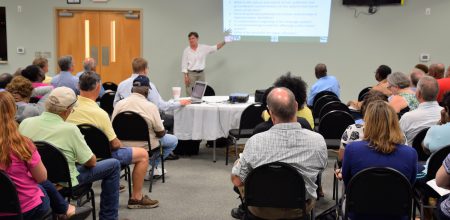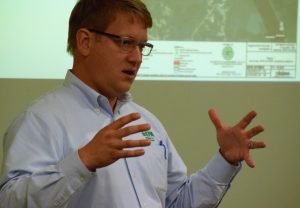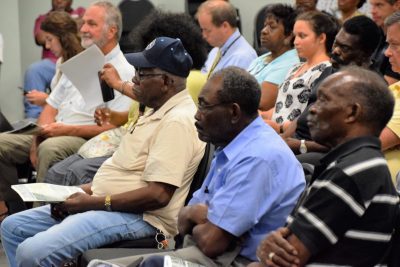
NAVASSA – Officials involved in cleaning up the contamination left here decades ago by a wood-treatment operation say the process will take years, but now that an initial investigation of the Superfund site is complete, a new phase in the effort is about to begin.
Federal, state and other officials updated town residents Tuesday for the first time in about a year on the status of the ongoing work at the former Kerr-McGee Chemical Corp. site. The 251-acre waterfront property in this Brunswick County town is where wood for railroad ties and telephone poles was pressure treated with creosote, a coal tar-based preservative, from 1936 until 1974. The U.S. Environmental Protection Agency, the lead agency in the cleanup, placed the site on a national priority Superfund sites in 2010 because of contamination of groundwater, soils and sediments.
Supporter Spotlight
About 65 attended the meeting, including presenters, at the Navassa Community Center on Main Street.
Erik Spalvins, the EPA’s remedial project manager for the site, described the Superfund process as a “formalized, step-by-step, problem-solving approach” that can take as long as 15 years. During the current remedial investigation phase, the past 18 or so months, more than 500 soil samples have been taken at the site, Spalvins said.

“We hope that we can start to assemble some of these results and evaluate where the remaining question marks are and then in 2017 we can produce a document that will be a remedial investigation report,” Spalvins said. “What it’s going to cover is where the contamination is, here’s how high the levels are, here’s how that compares to what a safe level would be and here’s the risks.”
Attention will then turn to the possible options for cleaning up the site – a feasibility study that considers available technologies for cleaning up or containing the contamination.
“Then we make a recommendation as to what we propose to do, that’s the proposed plan, and the EPA makes a decision about which of these options we propose to do,” Spalvins said, adding that options could include drilling wells, building structures to contain the contamination underground or removing soil.
Supporter Spotlight
Public meetings are to be held throughout, at each stage of the process, to update residents and receive input.
“I’d say that we’re probably a couple of years from having that proposed plan stage,” Spalvins said. “The remedial design stage might take nine months or a year. Remedial action on a site like this could take two, three, four years for the soil and where we have to deal with groundwater it could take a lot longer.”
An attendee asked about having enough money to finish the cleanup.
Spalvins said the Multistate Environmental Response Trust, which was created in 2011 as result of a more than $5 billion court settlement against the Kerr-McGee Corp. and other related subsidiaries of Anadarko Petroleum Corp., was part of the largest settlement ever for environmental fraud.

“For this site right now there’s about 90-plus million dollars to pay for this cleanup,” Spalvins said. “If the cleanup is not finished, then the EPA will do it with taxpayer money with the state doing cost share. If we are able to do it for less than that, then leftover funds are going to be returned to other sites that the trust manages where they didn’t have enough money.”
The trust could be involved with the site for 20 years, he said.
“Creosote gets into the ground a lot easier than it gets out,” said Lauri Gorton, program manager with the Multistate Environmental Response Trust.
Gorton said the preferred plan is to treat and remove the contaminants, rather than to contain the material on site. Treatment and removal mean fewer limitations on future uses of the site, she said.
Some sites have been able to recycle creosote removed from ground for use at other wood-treatment operations, the officials said.
“No matter what approach we’ve done, the EPA is not going to just leave,” Spalvins said.
Gorton agreed, adding that if the site cannot be completely cleaned, then the trust will be around for the long term to continue monitoring conditions.
Initial Findings
Gorton said the investigation is showing what was expected to be found at the site. No high levels of contamination were found in surface soils where there were never active creosote operations or in areas that could put the public at risk.
The production area included a wastewater pond that was filled when the creosote operation was dismantled in 1980. Soil samples taken at the pond site show creosote contamination 80 feet below ground. Swampy areas in the marsh also show high levels of contamination.

Gorton said follow-up investigation work will begin at the site later this fall.
“What we’re going to see is additional sampling,” Gorton said. “We’ve got some spots want to follow up on.”
This includes the creosote processing areas that are thickly overgrown in the summer, Gorton said. The work will be easier when snakes and underbrush are less of a challenge to site workers.
“We want to make sure we do a comprehensive job,” Gorton said.
Officials said interviews with surviving former creosote workers could help pinpoint other potential areas of contamination that may not be well documented. Several former workers attended the meeting.
“It’s great to have access to a great resource like that,” Gorton said.
Some in attendance asked questions about how the pollution spreads in the groundwater and surface waters of nearby Sturgeon Creek and the Brunswick and Cape Fear rivers, the risks to human health and the kind of work that will take place at the site in the coming months.
Officials said there was no indication of groundwater contamination in the upland areas where there was no creosote production or in upland areas adjacent to the site, mainly because groundwater flows generally toward the creek. Detectable levels have been found in sediments in the rivers and marshes but not on the scale of the marsh immediately adjacent to the production area.
“The other piece of this is there were other wood treaters that have been around and these chemicals are pretty widespread in the environment when you start talking about being around docks and things like that,” Spalvins said. “We’ve detected them but we don’t see them at a level where we think that they’re causing problems.”
An attendee asked about the effects of contamination on the local marine life. Spalvins said fiddler crabs, clams, blue crab and finfish have been sampled, along with minnows found in ditches around the site.
There could be some “very local issues” with the marine life in the marsh but the contaminants don’t move up the food chain. That’s because, in mammals and fish, the chemicals are processed by liver and broken down.
Community Adviser
A community nonprofit group based here has stepped forward to fill the role of technical adviser to interpret EPA documents for townsfolk and assist in providing community input on EPA cleanup actions.
The Navassa Community Economic and Environmental Redevelopment Corp., or NCEERC, has submitted to the EPA a letter of intent to apply for a technical assistance grant from the EPA. The Superfund law allows for issuance of a single grant of up to $50,000 per site to a single nonprofit group, but other groups may partner with the local group. If no other group submits a letter of intent, the group may submit its application by Aug. 31. Any groups wishing to submit a separate application also have 30 days to submit a letter of intent or file a written request for a 30-day extension.
Tonya Spencer, EPA’s community involvement coordinator, explained that the grant allows the community to have a technical assistant to put EPA data into layman’s terms. That’s the adviser’s main role, to review scientific material and help community understand what it all means.
Another role is to gather community input that can help shape plans for future uses of the site.
“It’s almost like a consultant, except they’re working on your behalf,” Spencer said.
The multistate trust will also solicit input from the community about what it would like to see at the site, Gorton said.
“The main role of community is to pick up where the federal authority stops and provide a vision for the future of the community,” she said.







